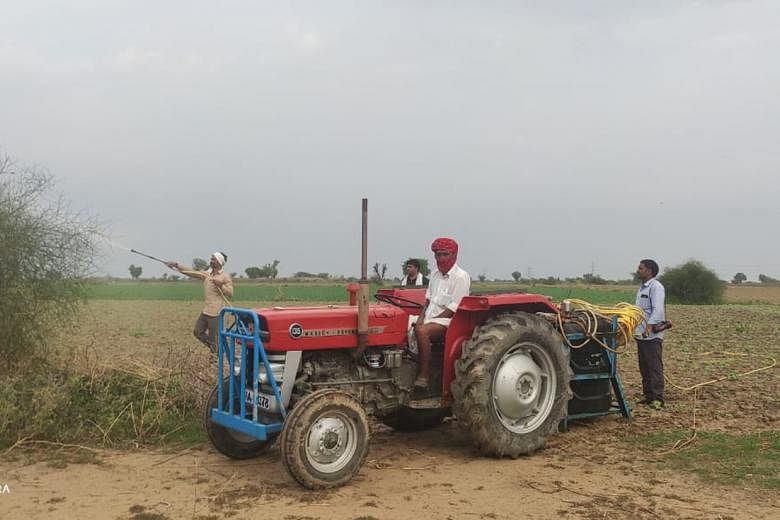NEW DELHI - The enemy is unknown; the weaponry, therefore, improvised.
Farmers in different parts of India are facing up to invading locusts - a threat many of them have never seen in their lifetime - with anything that can produce noise to chase them away.
Locals are clanging plates and pans. Firecrackers are being lit.
Even loudspeakers have been brought in to belt out dance music.
On June 24, it was Mr Chhoturam Rulaniya's turn.
That afternoon, locusts, which had until then flown over his farm, decided to settle on his property and nearby areas in Rajasthan's Nagaur district.
"It was as if disaster had struck us from the skies," said Mr Rulaniya, 60, describing the attack in and around five sq km of his farm.
Children were asked to run out with utensils. Mr Rulaniya revved his motorcycle engine.
Tarpaulin sheets were fanned around. All this to no avail.
"We would chase them away from the field, they would settle on the trees."
"We would chase them from there, they would return to the fields," Mr Rulaniya told The Straits Times.

By the time the authorities arrived with pesticides and vehicle-mounted sprays, it was too late.
The locusts had devoured fresh shoots of his groundnut, mung and gwar bean crop, causing a loss of around 250,000 rupees (S$4,660).
They were sown a month ago with hopes for a bumper harvest but there is no chance of that happening.
"The situation is pitiable for small and medium-scale farmers like me," he said, adding that alternative means of earning their livelihood - such as working in the construction sector - have become difficult because of the pandemic and its associated economic downturn.
Farmers like Mr Rulaniya are reeling from what is being described as the worst locust invasion in India since 1993.
Officials have struggled to control them for weeks since swarms began coming in from Pakistan and Iran in April, months before their usual arrival.
The crisis has its origins amid the worst outbreak of desert locusts in eastern Africa in decades, which has seen favourable breeding weather since 2018 caused by high rainfall.
Incoming locust swarms have spread wider in India in search of food because of the lower availability of vegetation in summer months.
They have moved as far as Nepal to the east, covering more than six states under their trajectory.
On June 27, locusts were seen flying through Gurugram, one of Delhi's satellite cities, before even passing through outlying parts of India's capital city, a spectre not witnessed for more than half a century.
The resulting loss of food and animal fodder has slashed incomes for farmers, exacerbating the impact of the ongoing Covid-19 pandemic on families in rural areas.
While the damage has been limited so far as not many crops are grown and harvested during summer, there are growing fears of a devastating impact on the forthcoming major harvest that follows the rainy season if these swarms persist.
A 1 sq km swarm of desert locusts can eat the same amount of food in one day as about 35,000 people, according to the United Nation's Food and Agricultural Organisation (FAO).
Locust swarms can vary from less than 1 sq km to several hundred sq km.
In its June 27 update, the FAO said that spring-bred swarms are present along both sides of the Indo-Pakistan border where they are awaiting monsoon rains that will allow them to mature and lay eggs.
It has asked India to remain on "high alert" during the next four weeks and warned of the possibility of swarms from northern Somalia migrating to areas along the Indo-Pakistan border.
More than 60 ground teams from India's Locust Warning Organisation (LWO) are involved in control operations in four different states and have sprayed pesticides on more than 200,000 hectares.
"We are worried but we are strengthening our resources and control potential day by day. Hopefully, we will be able to contain it," Dr K. L. Gurjar, LWO's deputy director, told The Straits Times.
Besides augmenting the number of vehicle-mounted sprays and requisitioning helicopters for aerial spraying, drones have been pressed into service as well for the first time.
India has also supplied pesticides to Iran and Pakistan but experts have called for greater coordination between affected countries to deal with this common threat.
Dr Bhagirath Choudhary, the founder director of South Asia Biotechnology Centre, an agricultural think-tank, said he is worried by reports of in-breeding in areas along the border with Pakistan as well as how swarms have been disintegrating this time into smaller groups and moving wider in different directions.
"All this has put a severe strain on government resources," he told ST.
The damage caused by locusts, he said, can be akin to that of a severe drought or flood that comes every one or two decades.
"These are disasters that are not manageable by individual farmers.
It is the same with locusts," added Dr Choudhary.
"Their attacks should be qualified as a biological disaster so that farmers can access compensation easily under the Pradhan Mantri Fasal Bima Yojana (a government crop insurance scheme for farmers)."


